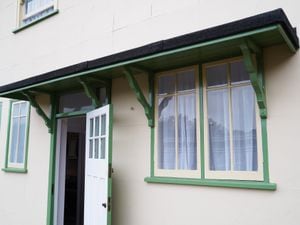Take a trip between decades to see new housing exhibition
A new exhibition is set to show the changes in housing in the years following the Second World War.

From the austerity of 1940s Britain to a nation gripped by football fever in the 1960s, visitors to Black Country Living Museum will be able to travel back two decades in just a few footsteps in their reopened Cast Iron Houses.
The Cast Iron Houses, two 1920s semi-detached council houses that were first built in the Brewery Fields Estate in Dudley in response to a shortage of housing at the end of World War One, were translocated and then rebuilt near the Museum’s Rolfe Street entrance in 1995.
To make way for the Museum’s purpose-built Visitor Centre, they were taken down in 2019 and moved again, making them one of the most well-travelled buildings in the Black Country.
Now situated next to the Museum’s recreation of Lea Road Infant Welfare Centre, Lench’s Oliver Shop and Folkes Park, one of the houses is set in 1940 while the other is set in 1968.
The 1940 house provides visitors a glimpse of everyday life in wartime Dudley. At the point at which the house will be set, bombing attacks will have reached as far inland as the Black Country.
Visitors will meet new costumed characters, including the Museum’s interpretation of Beatrice Vernon.

Beatrice moved with her husband, Sgt Sidney Vernon, when he was promoted to Sergeant in the Dudley police and was awarded a council house, where they remained until after the war with their son Basil and daughter Pat.
Following lodgings in Rock Hill and Tividale Street, Beatrice and her family were offered one of the brand-new cast iron houses in Ernest Road. They remained there until after the war.
The Museum has been in touch with Pat Vernon (later Smith) since 1995 when the house was originally opened.
Pat shared her very detailed memories with the Museum, which has helped with the stories the Museum has chosen, including the Penny family (Beatrice’s sister) who evacuated from London to stay with them.
Next door, the 1968 house shares a snapshot of life for the Aston family, who moved into one of the houses in Birmingham Road.
John and Alan Aston, sons of Daphne and Bill, have been instrumental in bringing the interior to life, working with the Museum since 2018, donating their objects and memories and making sure that the Museum’s recreation is faithful.
As visitors explore the two houses, they will be able to look around bedrooms, kitchens and living rooms. They will spot familiar brands, objects and clothing, including football paraphernalia and film star posters.
An exposed cast iron panel can also be found on the adjoining wall of the houses, a reminder of the unique construction of the experimental build.
To find out more, go to bclm.com.





